|
|
|
|
Time-shift imaging condition for converted waves |
We illustrate the imaging and angle-decomposition methods derived
in this paper with a synthetic example.
The reflectivity model consists of five reflectors of increasing
slopes, from ![]() to
to ![]() , as illustrated in
Figure 1(a).
In this experiment,
the P-wave velocity is
, as illustrated in
Figure 1(a).
In this experiment,
the P-wave velocity is ![]() m/s and
the S-wave velocity is
m/s and
the S-wave velocity is ![]() m/s.
We chose those velocities in order to capture reflections off the
steeper dipping reflectors in a reasonable acquisition geometry.
In this experiment, we analyze one common-image gather located
at the same horizontal position as the surface seismic source.
In this way, the reflector dip is equal to the angle of incidence
on each reflector.
m/s.
We chose those velocities in order to capture reflections off the
steeper dipping reflectors in a reasonable acquisition geometry.
In this experiment, we analyze one common-image gather located
at the same horizontal position as the surface seismic source.
In this way, the reflector dip is equal to the angle of incidence
on each reflector.
Figure 1(a) shows a schematic of a converted-mode (PS)
experiment. Given the constant velocity of the model,
the single-mode data from the reflector dipping more than ![]() would not be recorded at the surface.
In contrast, the converted-mode data from all reflectors
are recorded at the surface.
would not be recorded at the surface.
In contrast, the converted-mode data from all reflectors
are recorded at the surface.

|
|---|
|
ps
Figure 2. Synthetic PS reflection data |
|
|
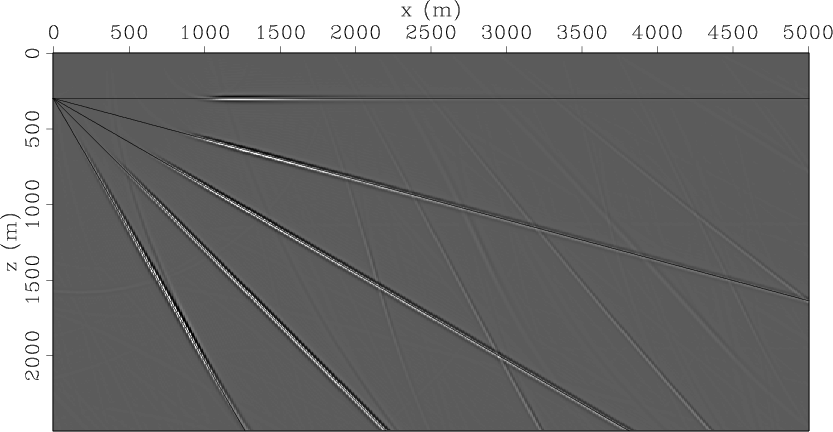
|
|---|
|
psimg-h
Figure 3. Migrated image for PS data |
|
|
Figure 2 shows the converted-mode seismic data from all five reflectors. We analyze the positive offsets of the seismic data which contain the reflections from the interfaces in the model.
We migrate this shot using one-way wavefield extrapolation using space-shift and time-shift imaging conditions. Figure 3 shows the migrated image at zero shift. As predicted by theory, this image is identical for both space-shift and time-shift imaging conditions when the values of the shift is zero.
Figures 4(a)-4(c)
show different views of the common-image gather (CIG) located at the
same horizontal location as the source ![]() m.
Panel (a) depicts the CIG resulting from the space-shift imaging
condition. The vertical axis represents depth
m.
Panel (a) depicts the CIG resulting from the space-shift imaging
condition. The vertical axis represents depth ![]() and the horizontal
axis represents horizontal space-shift labeled, for simplicity,
and the horizontal
axis represents horizontal space-shift labeled, for simplicity, ![]() .
Panel (b) depicts the same CIG after slant-stack in the
.
Panel (b) depicts the same CIG after slant-stack in the ![]() space.
The horizontal axis is the slant-stack parameter, which is related to
the reflection angle at every reflector, except for a correction based
on dip and the
space.
The horizontal axis is the slant-stack parameter, which is related to
the reflection angle at every reflector, except for a correction based
on dip and the ![]() ratio.
Panel (c) depicts the same CIG after transformation to reflection
angle
ratio.
Panel (c) depicts the same CIG after transformation to reflection
angle ![]() using local values of P and S velocities, as well as a
correction for the structural dip measured on the migrated image
depicted in Figure 3.
As expected, each reflector is represented in this final plot at
a specific angle of incidence. The vertical lines indicate the
correct reflection angles of converted waves reflecting from the
interfaces dipping at angles between
using local values of P and S velocities, as well as a
correction for the structural dip measured on the migrated image
depicted in Figure 3.
As expected, each reflector is represented in this final plot at
a specific angle of incidence. The vertical lines indicate the
correct reflection angles of converted waves reflecting from the
interfaces dipping at angles between ![]() and
and ![]() .
.
Figures 5(a)-5(c) show a similar analysis
to the one in Figures 4(a)-4(c) but for
imaging using time-shift.
Panel (a) depicts one CIG at ![]() m,
panel (b) depicts the CIG after slant-stack in the
m,
panel (b) depicts the CIG after slant-stack in the ![]() space, and
panel (c) depicts the CIG after transformation to reflection angle,
including the space-domain corrections for structural dip and
space, and
panel (c) depicts the CIG after transformation to reflection angle,
including the space-domain corrections for structural dip and
![]() ratio.
ratio.
As for the space-shift images, the energy corresponding to every reflector
from the CIG obtained by time-shift imaging concentrates well in the
slant-stack panels, Figures4(b) and 5(b).
However, a striking difference occurs in the ![]() panels:
while the energy for every reflector
in Figure 4(c) concentrates well,
the energy in Figure 5(c) is much less focused,
particularly at small angles.
panels:
while the energy for every reflector
in Figure 4(c) concentrates well,
the energy in Figure 5(c) is much less focused,
particularly at small angles.
This phenomenon was observed and discussed in detail by
Sava and Fomel (2005a), and it is related to the lower angular resolution
for time-shift imaging at small angles. This fact is illustrated
in Figures 6(a)-6(b) depicting impulse response
transformations for time-shift imaging:
panel (a) depicts various events in a slant-stack panel,
similar to Figure 5(b), and
panel (b) depicts the same events in a reflection angle panel,
similar to Figure 5(c).
At small reflection angles, the angular resolution is low, but it increases
at large reflection angles to levels comparable with those of
reflections mapped using space-shift imaging.
The simple explanation for this phenomenon is that
the space-shift transformation involves the ![]() trigonometric
function whose slope at
trigonometric
function whose slope at
![]() is equal to
is equal to ![]() ,
while the time-shift transformation involves the
,
while the time-shift transformation involves the ![]() function
whose slope at
function
whose slope at
![]() is equal to
is equal to ![]() .
Thus, even given equivalent slant-stack resolutions,
the angle resolution around
.
Thus, even given equivalent slant-stack resolutions,
the angle resolution around ![]() is poorer for time-shift
imaging than for space-shift imaging because of the
different trigonometric function.
is poorer for time-shift
imaging than for space-shift imaging because of the
different trigonometric function.
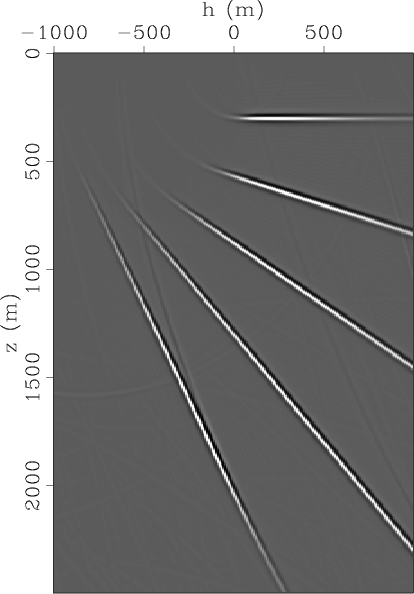
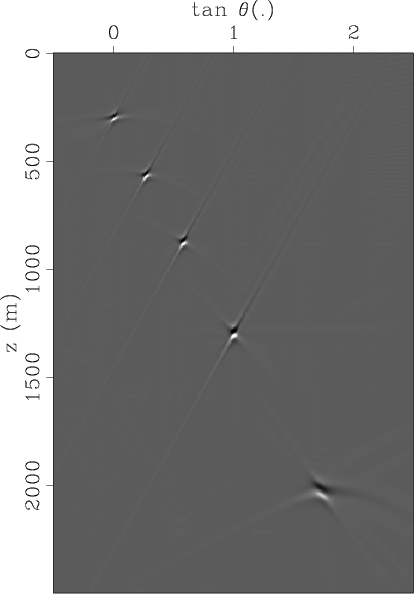
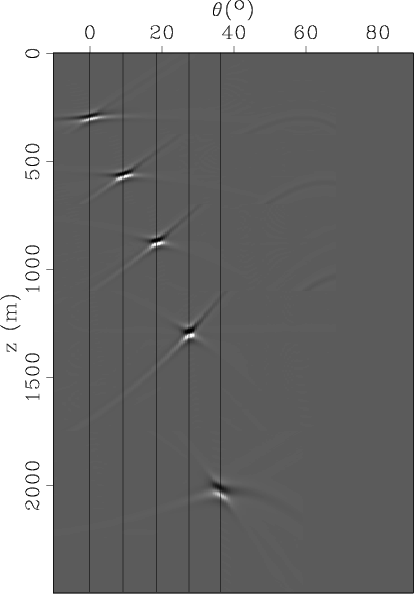
|
|---|
|
psoff-h,psssk-h,psang-h
Figure 4. Common-image gather at |
|
|
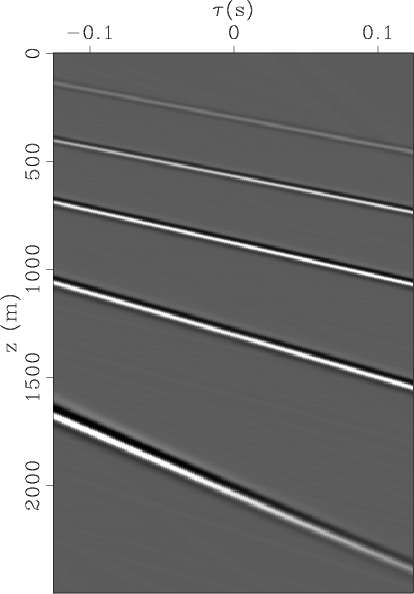
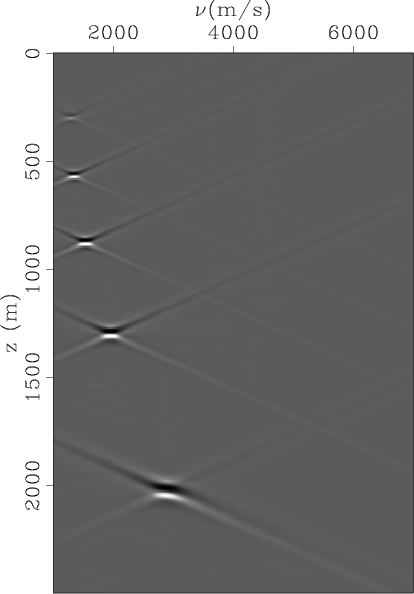
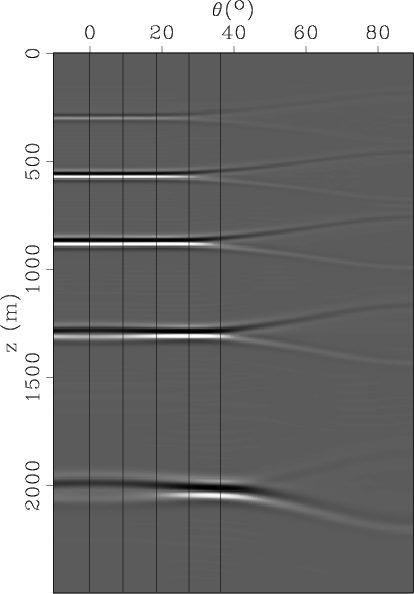
|
|---|
|
psoff-t,psssk-t,psang-t
Figure 5. Common-image gather at |
|
|
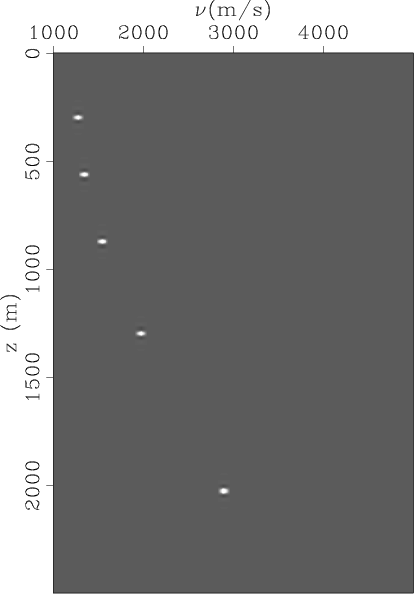

|
|---|
|
ssk,cor
Figure 6. Resolution experiment for time-shift imaging condition: simulated slant-stack (a) and angle-decomposition (b). Although the slant-stack is well focused for all events both function of depth |
|
|
|
|
|
|
Time-shift imaging condition for converted waves |